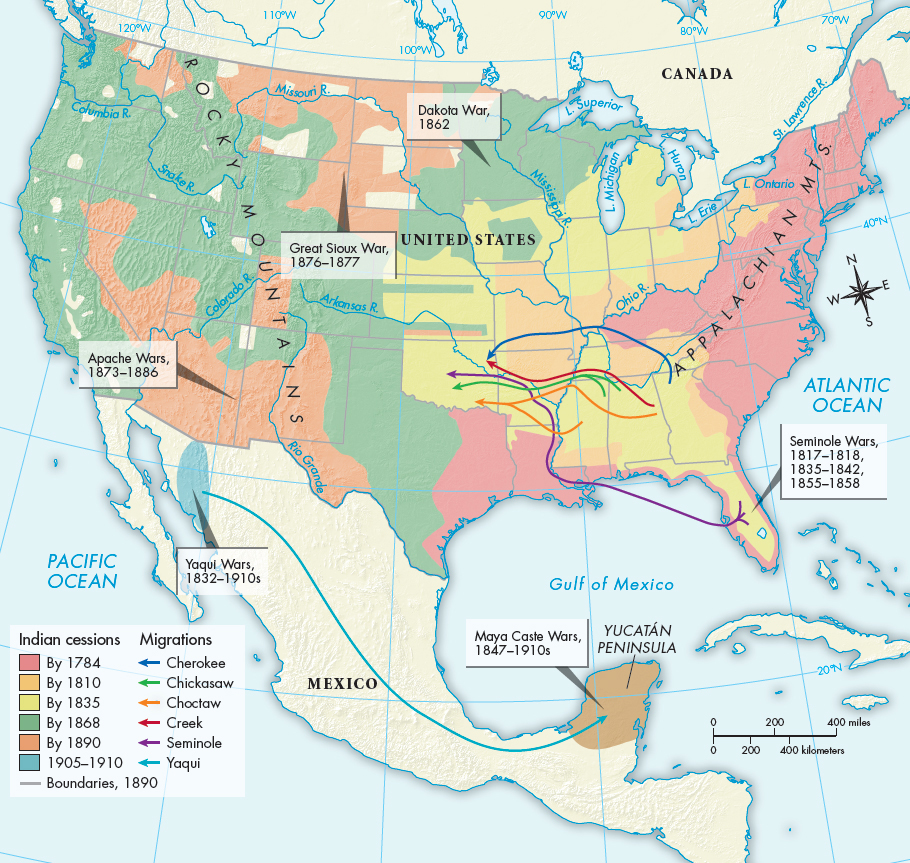Mexico and the United States
The rumblings of independence first stirred Mexico in 1810. A century later, in 1910, the country was engulfed in the first great social upheaval of the twentieth century, the Mexican Revolution. In the century between these events, Mexico declined politically and economically from its status as the most prosperous and important colony of the Spanish Empire. It lost most of its national territory as Central American provinces broke away and became independent republics and as the United States expanded westward and captured, purchased, or otherwise wrangled away Mexico’s northern lands.
Mexicans experienced political stabilization and economic growth again in the second half of the nineteenth century when liberal leaders, especially the dictator Porfirio Díaz (r. 1876–

Mexico’s woes after independence resulted mainly from the inability of its political leaders to establish a consensus about how to govern the new nation. The general who led the war against Spain, Agustín de Iturbide, resisted liberal pressure for a republican constitution and proclaimed himself emperor in 1822. When he was deposed a year later, the country’s southern provinces broke away, forming the new nations of Guatemala, Honduras, Nicaragua, El Salvador, and Costa Rica. For the next three decades, power in Mexico rested in the hands of regional caudillos and local bosses. The presidency changed hands frequently as rival factions competed against each other. Antonio López de Santa Anna, the most powerful of Mexico’s caudillos, held the presidency ten times between 1833 and 1854 — three separate times in 1833 alone.
By contrast, the United States established a clearer vision of government based on the shared principles and difficult compromises written into the 1789 Constitution. Deep differences of opinion remained over questions such as the power of the federal government relative to state governments, which played out in debates about the future of slavery and of westward expansion. These differences created regional tensions that lasted well into the early nineteenth century and culminated in the Civil War (1861–
Economically, the United States remained integrated into the expanding and industrializing British Empire, so U.S. merchants retained access to Atlantic markets and credit. But the United States faced deepening regional differences: in the first half of the nineteenth century the North’s economy and population grew faster than the South’s, and the North became the center of immigration, banking, and industrialization. In the South slavery and tenant farming kept much of the population at the economic margins and weakened internal markets. Slavery also inhibited immigration, since immigrants avoided settling in areas where they had to compete for work with unfree labor.
The dichotomy between the economies of the U.S. North and South repeated itself in the difference between the economies of the United States and Latin America. The Spanish imperial economy imploded in the course of the Napoleonic invasion, followed by the Peninsular War in which different factions in Spain, claiming to act in their deposed king’s name, fought their French occupiers (1808–
The fate of the major silver mine in Mexico illustrates the challenges presented by independence. La Valenciana in central Mexico was the site of the greatest private investment in the colony and was the most productive silver mine in the world. It was one of the first places where the steam engine, developed by Scottish inventor James Watt, was used to pump water out of shafts and to allow the mine to drill well below the water table. The machinery was destroyed during the wars of independence (1810–
Mexico entered a vicious cycle: without capital and economic activity, tax revenues evaporated, public administration disintegrated, and the national government became unmanageable. In turn, the lack of political stability drove investors away. The consequences are striking when measured against the experience of the United States. In 1800 Mexico produced half the goods and services that the United States did; by 1845 production had dropped to only 8 percent. Per capita income fell by half. At independence in 1821, Mexico had a population of 6.2 million, while the United States had 3.9 million. In 1900 Mexico’s population had barely doubled to 13.6 million, while the U.S. population increased nearly twenty times, reaching 76 million.3
Politically and economically weakened after independence, Mexico was vulnerable to expansionist pressure from the United States. At independence, Mexico’s northern territories included much of what is today the U.S. Southwest and West, stretching from Texas to California. These northern territories attracted the interest of U.S. politicians, settlers, and land speculators. In the 1820s settlers from the U.S. South petitioned the Mexican government for land grants in the province of Texas, in return for which they would adopt Mexican citizenship. The U.S. government encouraged these settlers to declare the independence of Texas in 1836. The Battle of the Alamo (1836) was a rare Mexican victory in the failed effort by caudillo Santa Anna to retake the province.
After Texas and Florida became U.S. states in 1845, President James Polk expanded the nation’s border westward, precipitating the Mexican-